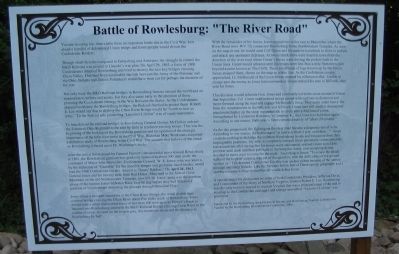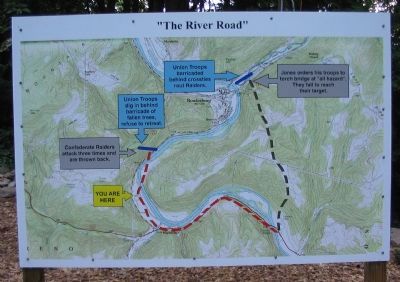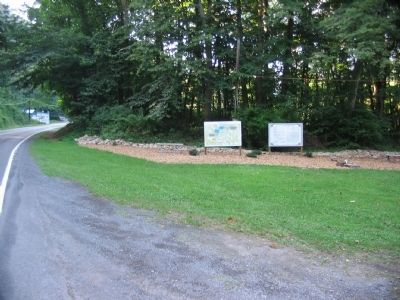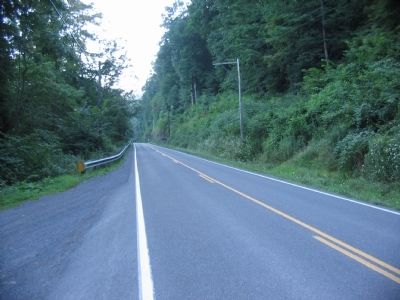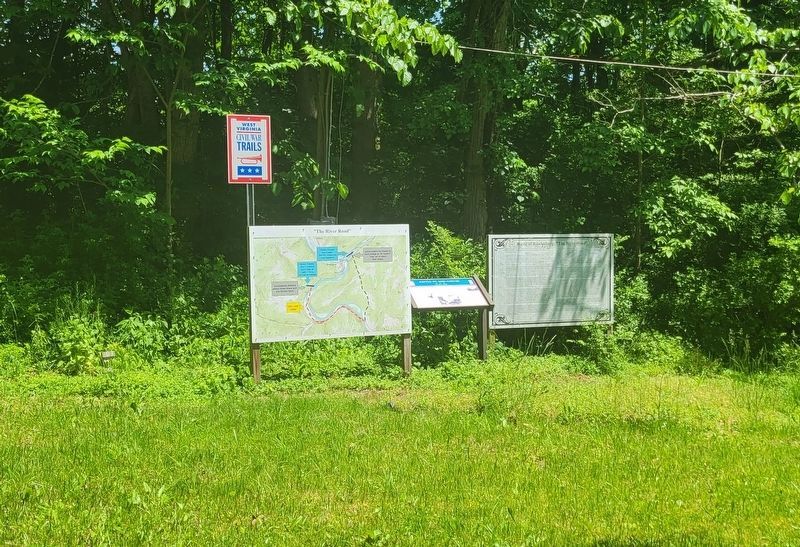Near Rowlesburg in Preston County, West Virginia — The American South (Appalachia)
Battle of Rowlesburg: "The River Road"
Though small in scale compared to Gettysburg and Antietam, the struggle to control the B&O Railroad was pivotal in Lincoln's war plan. On April 26, 1863, a force of 1500 Confederates attacked Rowlesburg and tried to destroy the two key bridges crossing Cheat Valley. Had they been successful, the link between the Army of the Potomac and the Ohio, Indiana and Illinois Volunteers would have been cut for perhaps the duration of the war.
Not only were the B&O Railroad bridges in Rowlesburg famous around the world and an inspiration to writers and artists, but they also came early to the attention of those planning the Confederate strategy in the War Between the States. As the Confederates planned to destroy the Rowlesburg brides, the Federals hurried to protect them. Robert E. Lee would say that to destroy the Cheat River Bridge would be "worth to him an army." To the Federal side preserving "Lincoln's Lifeline" was of equal importance.
To help defend the railroad bridges in Rowlesburg General George McClellan ordered the Sixteenth Ohio Regiment to be sent by train to reinforce existing troops. This was the beginning of the buildup of the Rowlesburg garrison and recognition of the strategic importance of the little river town in the Civil War. Historian Mike Workman completed a definitive study of Rowlesburg in the Civil War. The account that follows of the attack on Rowlesburg is based upon Dr. Workman's study.
After the initial threat posed by General Garrett's unsuccessful move toward Rowlesburg in 1861, the Rowlesburg garrison was gradually reduced to about 300 men under the command of Major John Showalter. Confederate General, W.E. Jones, who was known by the nickname of "Grumble" for his irascible temper and profanity-laced tirades, would lead the 1500 Confederate cavalry, known as "Jones' Raiders." On April 26, 1863, General Jones and his cavalry rode from Red House, Maryland to the foot of Cheat Mountain on the old Northwestern Turnpike, now US 50. Jones' party was the northern prong of the famous Jones-Imboden Raid. Just the day before they had defeated as garrison of Union troops defending the passage through Greenleaf Gap.
Jones chose a two-part maneuver at the Cheat River Bridge, the wood double span covered bridge crossing the Cheat River about five miles south of Rowlesburg. Jones would send a small dismounted force of less than 100 men up over Palmer's Knob to descend into Rowlesburg and torch the B&O Railroad Bridge crossing Cheat River in the middle of town. As seen on the map in grey, this maneuver shortened the distance to Rowlesburg by half.
With the remainder of his forces, Jones moved two miles east to Macomber where the River Road (now WV 72) connected Rowlesburg to the Nortwestern Turnpike. As seen on the map in red, he would send Col. Green and his men on horseback to drive in pickets and attack any perimeter defenses. At two o'clock shots were heard in town from the direction of the river road where Green's forces were driving the pickets back to the Union lines. Green would advance until his troops were less than a mile from town, just beyond a point known as The Cliffs. There a barricade of logs thrown up by the Union forces stopped him, shown on the map as a blue line. As the Confederate cavalry approached, Lt. McDonald of the Union forces ordered his riflemen to fire. Unable to charge past the enemy as Jones had commanded, Green ordered his men to fall back, then sent for Jones.
This decision would infuriate Gen. Jones and eventually led to the court-martial of Green that September. Col. Green next ordered troops armed with carbines to dismount and move forward along the road and engage McDonald's force. They came under heavy fire from the mountaineers in the rifle-pits and fell back. Green sent still another dismounted attachment higher up the steep mountainside to circle above McDonald's men. Strengthened by Lieutenant Hathaway's Company K., the Union line held once again. According to one source, Hathaway's force consisted mainly of "about 20 citizens."
As the day progressed, the fighting on the river road became a desperate test of wills. According to one source, the battle raged "at intervals from 3 p.m. until dark....". Green could do nothing to dislodge the stubborn Rowlesburg troops and townsmen from their impregnable positions. By now, a completely enraged Jones personally commanded the last assault but after seeing that his troops were stalemated, ordered Green to hold his position until dusk and then pull back to the turnpike. Jones, now accepting defeat, decided to move west to camp for the night. According to Jones, "To renew the attack without the hope of surprise was out of the question, with the difficulties of the ground against us." The dreaded Confederate Cavalry was useless to him because of the narrow passage and steep hillside. Like the Persians before him at Thermopylae, geography and a stubborn enemy willing to sacrifice all would defeat Jones.
A special target for destruction by order of both Confederate President, Jefferson Davis, and Commander of the Army of Northern Virginia, General Robert E. Lee, Rowlesburg was the only town or outpost in western Virginia that was a principal target of the raid to stand up to the Confederate onslaught and emerge unscathed. "Lincoln's
Lifeline" was preserved.
Erected 2008 by Rowlesburg Area Historical Society , Rowlesburg Tourism Commission, and Rowlesburg Revitalization Committee.
Topics. This historical marker is listed in these topic lists: Railroads & Streetcars • War, US Civil. A significant historical month for this entry is April 1624.
Location. 39° 19.595′ N, 79° 41.665′ W. Marker is near Rowlesburg, West Virginia, in Preston County. Marker is on River Road (State Highway 72) 0.6 miles north of Northwestern Turnpike (U.S. 50), on the right when traveling north. Touch for map. Marker is in this post office area: Rowlesburg WV 26425, United States of America. Touch for directions.
Other nearby markers. At least 8 other markers are within 2 miles of this marker, measured as the crow flies. Battle of Rowlesburg (here, next to this marker); Rowlesburg Veterans Memorial (approx. 1.9 miles away); Downtown Rowlesburg (approx. 1.9 miles away); Tray Run Viaduct (approx. 1.9 miles away); Independent Order of Odd Fellows Building and Property (approx. 1.9 miles away); Civil War Memorial (approx. 1.9 miles away); The Great Flood of November 4-5, 1985 (approx. 1.9 miles away); Rowlesburg School (approx. 2 miles away). Touch for a list and map of all markers in Rowlesburg.
Credits. This page was last revised on May 27, 2022. It was originally submitted on August 3, 2010, by Craig Swain of Leesburg, Virginia. This page has been viewed 2,240 times since then and 250 times this year. Photos: 1, 2, 3, 4. submitted on August 3, 2010, by Craig Swain of Leesburg, Virginia. 5. submitted on May 27, 2022, by Bradley Owen of Morgantown, West Virginia.
